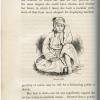Drawing of a Bosnian woman
Commentary
Drawing in pencil by Arthur Evans of a woman, captioned ‘Sitting for her likeness’, identified as a young Bosnian woman (‘belle’) sketched at the annual fair at the hillside shrine near Komušina, Bosnia and Herzegovina.
Artist: Arthur John Evans
Date of drawing: August 1875
Continent: Europe
Geographical area: Southern Europe
Country: Bosnia and Herzegovina
Region/Place: Komušina
Cultural group: European Bosnian
Format: Drawing
Size: 135 x 82 mm
Acquisition: Joan Evans. Donated August 1941
***
Exhibition caption: ‘One of a selection of drawings and ink sketches made by Arthur Evans while travelling with his brother through Bosnia and Herzegovina in the summer of 1875. They show people and places encountered by the pair on a route south from Agram (modern-day Zagreb) – via Tešanj, Sarajevo and Mostar – to Ragusa (Dubrovnik), which Evans and his wife were later to make their home. The illustrations demonstrate a particular interest in identity and dress, Evans writing, for example, of finding “two Bulgarians hard at work tying up bundles of onions, clad in their dark national costume – the brown tight-sleeved jacket embroidered with black, the dull red sash, the brown trowser-leggings which are equally Turkish and Tartar and on their head the black sheepskin cap which had at first attracted my attention.” As well as being an aide-mémoire, the drawings provided the basis for engravings published in Evans’ account of his journey, Through Bosnia and the Herzegóvina on Foot during the Insurrection, August and September 1875 (London, 1876). As an eyewitness account of a distant region in turmoil, the book was an immediate success, quoted extensively in Parliament, and it went into a second edition the following year.’ Source: ‘Travels in Finland and Bosnia-Herzegovina: An Ethnographic Collection of Sir Arthur Evans’, exhibition curated by Philip Grover, Pitt Rivers Museum, University of Oxford, 29 April to 1 September 2013.
Primary documentation: ‘[p.588] Dr. JOAN EVANS, from the property of the late SIR ARTHUR EVANS, Youlbury, Boars Hill, Oxford. [List of items follows]’; ‘[p.590] 21 Original pencil sketches, types & scenery. BALKANS’: Pitt Rivers Museum accession records (Donations X, 1937–1941), pp.588, 590. Annotations on drawing: ‘Sitting for her likeness - (May be introduced into group No 2)/ Comušina’ (written in pencil below drawing).
Research notes: It has been identified by Philip Grover that this original drawing was used as the artwork for a woodcut engraving subsequently published in Arthur J. Evans, Through Bosnia and the Herzegóvina on Foot during the Insurrection, August and September 1875 (London, 1876), p.148, printed with the caption ‘Bosnian Belle’. Evans recorded in the volume: ‘But another maiden demands my presence, and I am called away to sketch, at her own request, a Bosnian belle, coiffed in the brightest of rosy kerchiefs, enveloped in a jacket with the most gorgeous golden border, and cinctured with a sash of orange and purple. Whether the attitude in which she sat for her portrait was the most elegant she could have chosen, and whether her boots, in which I fancy she took a peculiar pride, were of that form most adapted for displaying maidenly gracility of ankle, may be left for a forbearing public to decide./ Her hair is dark - nor let any ungallantly suggest that its hue is due to artificial causes. Granted that a powder does exist called Kna; let it freely be admitted that the fair Serbs often show themselves as desirous as ladies of the harem to acquire those raven tresses which the Koran distinguishes as a sign of comeliness and strength. But a glance - a scintillation - from those eyes would annihilate any detractor so mean as to bring such imputations against our Bosniac beauty! Here at once, so to speak, we are on terra firma. These at least are incapable of assuming an un-genuine hue; and they are black, black as the sloes with which the national poets delight to compare their mistresses’ orbs, and haloed round with such dark lashes and eyebrows as the same Serbian imagination fondly likens to “leeches from the fountain.” But she was rather the exception in the crowd, and the evident esteem in which her good looks were held was probably more due to this accident of hue than anything else; for if the women’s tresses were sometimes of the fashionable colour, their eyes were oftener of a traitorous turquoise than of jet’: Through Bosnia and the Herzegóvina on Foot, pp.147–149.

